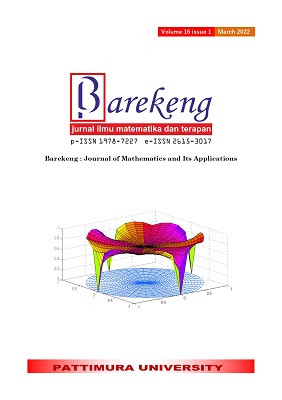OPTIMIZATION OF TUG SERVICES IN TANJUNG PERAK PORT USING ASSIGNMENT MODEL BASED ON FORECASTING RESULTS OF TUG SERVICES
Abstract
Optimizing adequate tugboat services is very much needed to support the operational improvement of the Tanjung Perak port. This study uses the triple exponential smoothing method to predict the number of tug service requests in 2021 and the assignment model to determine the optimal level of operating tugboats. The data used in this study is data on demand for tugboat services for small, medium, and large vessels from 2019 to 2020. Forecasting results show that the highest demand for small boat services is 4551 and 3235. The highest demand for medium vessel services is 479 and the lowest is 365. Meanwhile, for the highest demand for large ship services 61 and the lowest 40. The assignment results show the optimization of Tanjung Perak port by operating 13 tugboats every day.
Downloads
References
A. D. C. D. Nur, “Kapasitas Dukung Tiang Tunggal Terhadap Beban Lateral Bangunan Gudang Petikemas Pelabuhan Tanjung Perak,” AGREGAT, vol. 6, no. 1, pp. 493–498, 2021.
W. Wang, T. Zheng, and Y. Peng, “The Study of the Influence of Port Scale on Tugboat Configuration Based on System Simulation,” Adv. Intell. Syst. Res., vol. 159, pp. 4–7, 2018, doi: 10.2991/mmsa-18.2018.2.
R. Fajar and M. Basuki, “Perhitungan Berat Kapal Kosong Sebagai Fungsi Hari Daya Mesin Utama,” Semin. Teknol. Kebumian dan Kelaut. (SEMITAN II), vol. 2, no. 1, pp. 247–254, 2020.
S. Jia, C. L. Li, and Z. Xu, “Managing Navigation Channel Traffic and Anchorage Area Utilization of a Container Port,” Transp. Sci., vol. 53, no. 3, pp. 728–745, 2019, doi: 10.1287/trsc.2018.0879.
F. Hadi, H. Supomo, and T. Achmadi, “A Simulation Study of the Fleet Sizing Problem in Pilotage and Tug Services: Case Study of Tanjung Perak port, Surabaya,” IOP Conf. Ser. Mater. Sci. Eng., vol. 1052, no. 1, p. 012056, 2021, doi: 10.1088/1757-899x/1052/1/012056.
X. Wei, S. Jia, Q. Meng, and K. C. Tan, “Tugboat Scheduling for Container Ports,” Transp. Res. Part E Logist. Transp. Rev., vol. 142, no. September, pp. 1–23, 2020, doi: 10.1016/j.tre.2020.102071.
F. Jiang, Z. Han, and M. Quandang, “The Optimize of Tug Configuration Based on Fuzzy Comprehensive Evaluation and Entropy Weight Analysis,” IOP Conf. Ser. Earth Environ. Sci., vol. 809, no. 1, pp. 4–12, 2021, doi: 10.1088/1755-1315/809/1/012018.
S. M. Lee, J. H. Lee, M. Il Roh, K. S. Kim, S. H. Ham, and H. W. Lee, “An Optimization Model of Tugboat Operation for Conveying a Large Surface Vessel,” J. Comput. Des. Eng., vol. 8, no. 2, pp. 654–675, 2021, doi: 10.1093/jcde/qwab006.
C. C. Chou, C. C. Wen, and Y. J. Huang, “Analysis of Tugboat Operation and Towage Fees in a Taiwanese Port and Alternatives for Improving Tugboat Operation by the Delphi Method,” Proc. Inst. Mech. Eng. Part M J. Eng. Marit. Environ., vol. 235, no. 1, pp. 176–187, 2021, doi: 10.1177/1475090220927246.
T. Niu, L. Zhang, B. Zhang, B. Yang, and S. Wei, “An Improved Prediction Model Combining Inverse Exponential Smoothing and Markov Chain,” Math. Probl. Eng., vol. 2020, 2020, doi: 10.1155/2020/6210616.
K. Pulungan, “Penerapan Metode Tripel Exponential Smoothing Dalam Peramalan Keuntungan Perusahaan dalam Tingkat Penjualan Alat Tulis Kantor,” Build. Informatics, Technol. Sci., vol. 3, no. 1, pp. 43–47, 2021, doi: 10.47065/bits.v3i1.166.
F. Lawalata, E. Sediyono, and H. Purnomo, “Analisis Prediksi Jumlah Pasien Rawat Inap di Rumah Sakit GMIM Siloam Sonder Menggunakan Metode Triple Exponential Smoothing,” Jointer - J. Informatics Eng., vol. 2, no. 01, pp. 32–26, 2021, doi: 10.53682/jointer.v2i01.28.
D. M. Khairina, Y. Daniel, and P. P. Widagdo, “Comparison of Double Exponential Smoothing and Triple Exponential Smoothing Methods in Predicting Income of Local Water Company,” J. Phys. Conf. Ser., pp. 1–10, 2021, doi: 10.1088/1742-6596/1943/1/012102.
S. Madianto, E. Utami, and A. D. Hartanto, “Algoritma Triple Exponential Smoothing Untuk Prediksi Trend Turis Pariwisata Jatim Park Batu saat Pandemi Covid-19,” J. Appl. Informatics Comput., vol. 5, no. 1, p. 58, 2021, [Online]. Available: http://jurnal.polibatam.ac.id/index.php/JAIC.
Ramadiani, R. Syahrani, I. F. Astuti, and Azainil, “Forecasting the Number of Airplane Passengers uses the Double and the Triple Exponential Smoothing Method,” in Journal of Physics: Conference Series, Jun. 2020, vol. 1524, no. 1, doi: 10.1088/1742-6596/1524/1/012051.
I. Nabillah and I. Ranggadara, “Mean Absolute Percentage Error untuk Evaluasi Hasil Prediksi Komoditas Laut,” JOINS (Journal Inf. Syst., vol. 5, no. 2, pp. 250–255, 2020, doi: 10.33633/joins.v5i2.3900.
G. Airlangga, A. Rachmat, and D. Lapihu, “Comparison of Exponential Smoothing and Neural Network Method to Forecast Rice Production in Indonesia,” Telkomnika (Telecommunication Comput. Electron. Control., vol. 17, no. 3, pp. 1367–1375, 2019, doi: 10.12928/TELKOMNIKA.V17I3.11768.
L. Pamularsih, M. Mustafid, and A. Hoyyi, “Penerapan Seasonal Generalized Space Time Autoregressive Seemingly Unrelated Regression (SGSTAR SUR) Pada Peramalan Hasil Produksi Padi,” J. Gaussian, vol. 10, no. 2, pp. 241–249, 2021.
I. D. Febrianti, M. Hani, and U. D. Rosiani, “Optimasi Double Exponential Smoothing menggunakan Metode Golden Section untuk Peramalan Penjualan Sparepart,” Semin. Inform. Apl. Polinema, pp. 42–45, 2021.
Authors who publish with this Journal agree to the following terms:
- Author retain copyright and grant the journal right of first publication with the work simultaneously licensed under a creative commons attribution license that allow others to share the work within an acknowledgement of the work’s authorship and initial publication of this journal.
- Authors are able to enter into separate, additional contractual arrangement for the non-exclusive distribution of the journal’s published version of the work (e.g. acknowledgement of its initial publication in this journal).
- Authors are permitted and encouraged to post their work online (e.g. in institutional repositories or on their websites) prior to and during the submission process, as it can lead to productive exchanges, as well as earlier and greater citation of published works.






1.gif)



